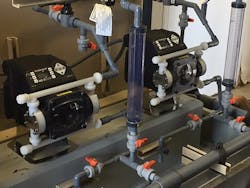Chemical Metering Pump Replacement at Camp Pendleton
By Amparo Burke
Marine Corps Base Camp Pendleton is the major West Coast base of the United States Marine Corps. It is located on the Southern California coast in San Diego County. The base maintains a self-sustaining water supply and sewage treatment plant to serve a population of 70,000.
Camp Pendleton has been using four diaphragm metering pumps to inject sodium hypochlorite into its finished potable water to pre- and post-chlorinate the drinking water for the base. The diaphragm pumping cycle consists of a suction and discharge phase. During the suction phase of the cycle, gaseous chemicals like sodium hypochlorite can cause vapor lock and the pump may lose prime. Because this application required intermittent pumping through duty and standby metering pumps, priming was a challenge for the previous diaphragm metering pumps.
Repair costs and downtime presented another problem with the existing diaphragm pumps. The pump repair kit was expensive (averaging around $1,200 per kit), and the complicated and messy repair job would take a full day.
The dual-diaphragm configuration of the ProSeries-M MD-3 means that when the first diaphragm is in the suction phase, the second diaphragm is in the discharge phase.
The diaphragm pumps in use at the facility were replaced with two of Blue-White Industries’ ProSeries-M® MD-3 double-diaphragm metering pumps for beta testing. The dual-diaphragm configuration means that when the first diaphragm is in the suction phase, the second diaphragm is in the discharge phase. This ensures the sodium hypochlorite is pumped in a near continuous flow, preventing gas build up and loss of prime.
Sean Donegan, a water treatment specialist with services management company ACEPEX, noted that “the MD-3 pumps have a smooth consistent flow, like peristaltic pumps, especially at low feeds.”
He added that “the MD-3 pumps are less expensive than other pumps, especially when comparing spare parts cost and time to repair.”
The MD-3 succeeded in pumping the gas-forming chemical in the high-pressure application, eliminating vapor lock. The pumps injected 12.5 to 16 percent of sodium hypochlorite at the rate of 5-7 GPH at 80-120 psi. The pumps maintained an accurate and continuous flow, providing smooth chemical dosing and eliminating the need for a pulsation dampener.
The pumps’ drop-in-place design and built-in controls greatly simplified installation and setup. “The wiring is simple labeled terminal blocks,” Donegan said, which made installation easy.
The pumps were installed on October 27, 2016, and have been running continuously with no maintenance needed. According to Keith Regalado, Camp Pendleton’s shift operator, “The pumps have worked perfectly since the installation and are accurate and consistent.” WW
Blue-White Industries is exhibiting at ACE19, booth 1831. Learn more at www.blue-white.com.
Circle No. 277 on Reader Service Card




